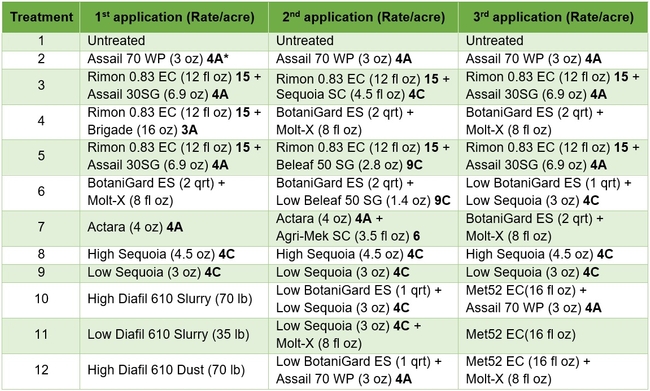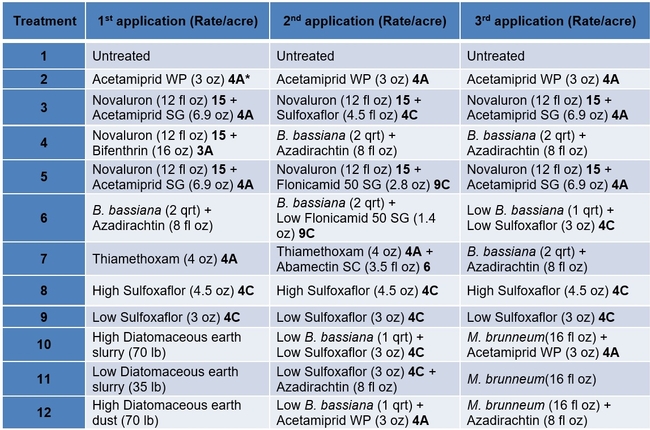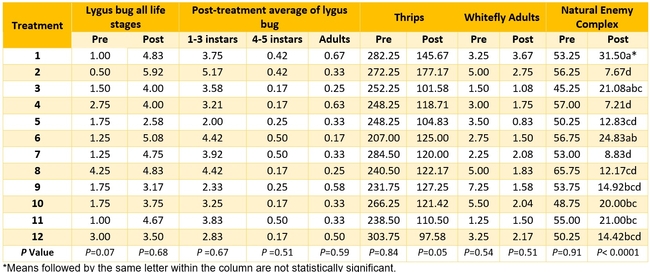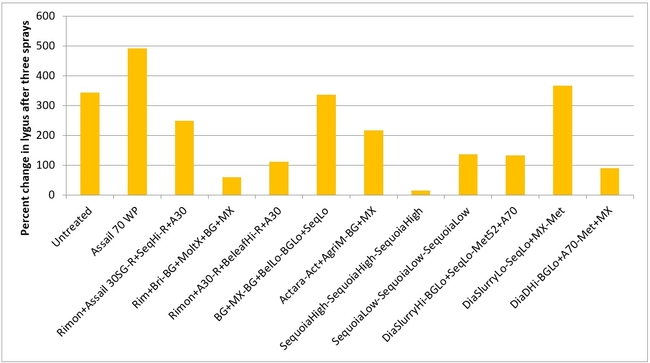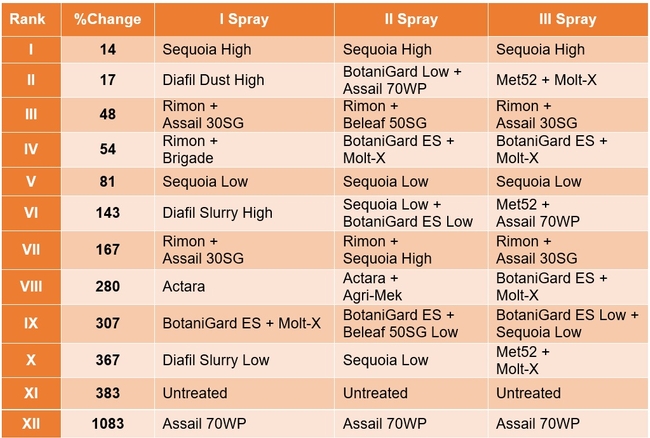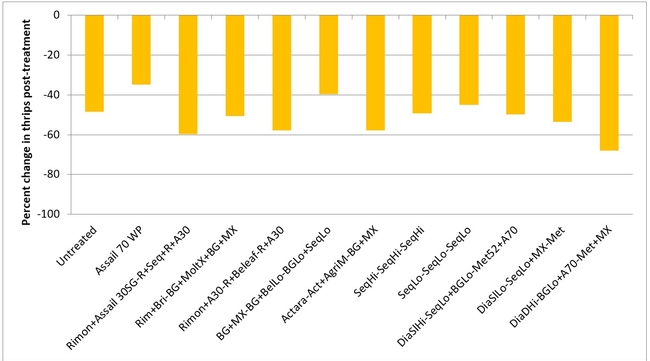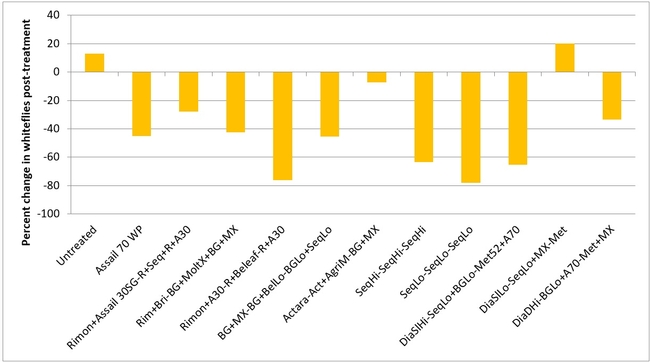Strawberry is an important commodity in California with a crop value of $2 billion (NASS, 2013). Lygus bug or western tarnished plant bug (Lygus hesperus), twospotted spider mite (Tetranychus urticae), greenhouse whitefly (Trialeurodes vaporariorum), and western flower thrips (Frankliniella occidentalis) are considered as important arthropod pests of strawberries which can cause significant yield losses. According to the Pesticide Use Report of California Department of Pesticide Regulation (2014), more than 200,000 lb of chemical insecticide and miticide active ingredients were used in strawberries in 2012. Among the 50,000 lb of biorational active ingredients that were additionally applied, 97% were Bacillus thuringiensis products used against lepidopteran pests. Apart from the release of various species of predatory mites against twospotted spider mites, pest management in strawberries is mainly dependent on chemical pesticides and IPM is generally limited to the rotation of pesticides in different modes of action groups.
In an effort to develop an effective IPM program with a particular emphasis on lygus bug management, research has been conducted for the past few years in Santa Maria to evaluate the role of various non-chemical alternatives. Field studies in 2013 showed that botanical and microbial pesticides can be effectively used in combination and rotation with chemical pesticides (Dara, 2014). Additional studies were conducted in 2014 to evaluate the efficacy of various combinations and rotations of new and existing chemical pesticides along with botanical, earth-based, and microbial pesticides.
Methodology
A large scale field study was conducted during June and July, 2014 in a conventional strawberry field of variety Del Rey at Goodwin Berry Farms, Santa Maria. Chemical pesticides included those from IRAC mode of action groups 3A (sodium channel modulators) 4A (neonicotinoids), 4C (sulfoximines), 6 (chloride channel activators), 9C (selective homopteran feeding blockers), and 15 (inhibitors of chitin biosynthesis). Additionally, diatomaceous earth, azadirachtin, and two entomopathogenic fungi, Beauveria bassiana and Metarhizium brunneum (formerly known as M. anisopliae) were also used. Diatomaceous earth is a powder form of fossilized remains of diatoms and contains silicon dioxide as an active ingredient. Silicon dioxide interferes with the integrity of the cuticle by absorbing the waxy layer and causes mortality due to desiccation. Both B. bassiana and M. brunneum are soilborne entomopathogenic fungi which cause infection when a conidiospore comes in contact with an insect or a mite. Azadirachtin, a secondary metabolite present in neem seed, is a limonoid compound which interferes with the synthesis of various proteins and thus affects molting, mating, sexual communication, and reproductive ability. It also has insecticidal properties and acts as an antifeedant and repellent. Using these alternatives can help pest management which is sometimes difficult to achieve with chemical pesticides alone.
Treatments included an untreated control, a wettable powder formulation of acetamiprid as the grower standard, and other materials in different combinations and rotations (Tables 1 and 2). Each plot had seven 75' long and 64” wide beds and treatments were replicated four times in a randomized complete block design. Treatments were administered late afternoon or in the evening using a tractor-mounted sprayer except for diatomaceous earth dust which was applied by a backpack dust applicator. Three applications were made at 7-8 day intervals and observations were made once before the first application and 5-6 days after each application. On each observation date, 20 plants were randomly sampled from the middle three beds of each plot by gently beating the plant to dislodge insects into a container. The number of aphids, lygus bugs (young and mature nymphs and adults), thrips, whitefly adults, and various species of natural enemies were counted from each plant. Natural enemy complex included bigeyed bug (Geocoris spp.), minute pirate bug (Orius spp.), lacewing (Chrysoperla spp. and Chrysopa spp.), damsel bug (Nabis spp.), lady beetle (multiple species), parasitoids (multiple species), and spiders (multiple species). Data were analyzed using statistical procedures.
Table 1. List of treatments used in this study and their application rates per acre – Active ingredients
*3A Sodium channel modulators 4A Neonecotinoids, 4C Sulfoxamines, 6 Chloride channel activators, 9C Selective homopteran feeding blockers, and 15 Inhibitors of chitin biosynthesis.
Table 2. List of treatments used in this study and their application rates per acre – Trade names
*3A Sodium channel modulators 4A Neonecotinoids, 4C Sulfoxamines, 6 Chloride channel activators, 9C Selective homopteran feeding blockers, and 15 Inhibitors of chitin biosynthesis.
Results and Discussion
Actual numbers of various pests and natural enemies are presented in Table 3 and percent change post-treatment compared to pre-treatment is presented in different figures.
Table 3. Pest and natural enemy populations from various treatments before and after treatment per 20 sample plants. Post-treatment counts include averages for three spray applications. Refer to Tables 1 and 2 for the list of treatments.
Aphid: Negligible number of aphids was seen only in few treatments and data are not presented.
Lygus bug: Lygus numbers increased in all treatments after treatment and there were no statistical differences (P > 0.05). However, when the percent change, compared to pre-treatment counts, was considered, some treatments appeared to be more effective than others in preventing population buildup. The high rate of Sequoia (treatment 8) limited the increase to 14% followed by the rotation of Diafil high rate-BotaniGard low rate+Assail 70 WP-Met 52+Molt-X (treatment 12) indicating the potential of non-chemical alternatives for lygus bug management (Table 4). When BotaniGard+Molt-X combination was applied twice after Rimon+Brigade combination (treatment 4), it appeared to be the fourth best rotation limiting the population build up to 54%. Untreated control and Assail 70 WP had the highest lygus numbers with 383% and 1083% increase, respectively.
Percent change in all stages of lygus bugs after three spray applications.
Treatments ranked according to their efficacy as expressed by the percent change/control of lygus bugs after three spray applications.
Thrips:There was a general reduction in thrips numbers post-treatment. There was a 48% reduction in their post-treatment numbers in untreated control while it varied from 35% treatment 2 to 68% in treatment 12.
Percent change in western flower thrips populations after three spray applications.
Whitefly adult:Most of the treatments reduced whitefly populations except for one treatment where there was a 20% increase (treatment 11 – Diafil low rate followed by Sequoia low rate+Molt-X, and Met 52) compared to a 13% in untreated control. There was a 7 to 78% reduction in whitefly populations in all other treatments.
Percent change in greenhouse whitefly adult populations after three spray applications.
Natural enemy complex:The number of big-eyed bug, parasitoids, and spiders significantly varied among various treatments post-treatment (P < 0.05, data not shown). When the percent change was considered for the entire natural enemy complex, there was a reduction in all treatments with 41% reduction in untreated control and 53-86% reduction in various treatments.
Diafil application left a white deposit on strawberry plants for several days making the berries unmarketable. It may not be practical for managing lygus bug, which usually appears after fruit production starts.
These results support last year's data in demonstrating the potential of non-chemical alternatives such as microbial and botanical pesticides. These tools are essential for sustainable pest management and can make a significant reduction in chemical pesticide use without compromising the control efficacy.
http://ucanr.edu/articlefeedback
References
California Department of Pesticide Regulation. 2014. Summary of pesticide use report data 2012: Indexed by commodity.
Dara, S. K. 2014. New strawberry IPM studies with chemical, botanical, and microbial solutions. CAPCA Adviser 17: 35-37.
National Agricultural Statistics Service (NASS) 2013. California agricultural statistics: 2012 crop year.
